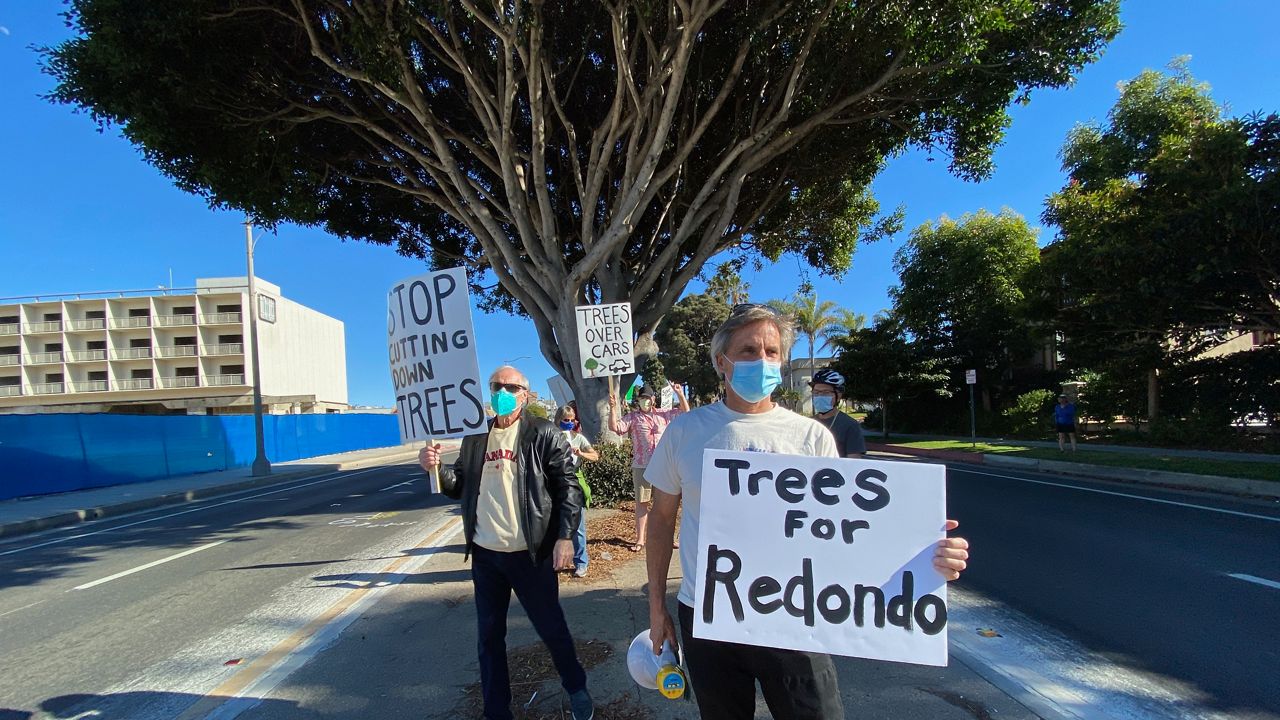TORRANCE, Calif. — At least a dozen activists, alongside two of Redondo Beach’s elected officials, stood in protest on a median bordering Torrance and Redondo on Sunday.
The message was clear: Save "Frankie the Ficus," a tree rooted in a median along Pacific Coast Highway, with a canopy that stretches over two and a half lanes of traffic.
The tree’s exact age isn’t clear, though Redondo Beach Mayor Bill Brand, who was shouting into a bullhorn Sunday afternoon, guessed it was around 50 or 60 years old. Brand and Redondo Beach Councilman Nils Nehrenheim were both at the protest on Sunday. (Both, coincidentally, are up for reelection in March.)
But their activism had an impact: the tree, which was slated for removal on Wednesday, has had a stay of execution. That stay will last at least until the City of Torrance’s Transportation Commission has had an opportunity to talk over the fate of the tree — and, perhaps more significantly, how the tree impacts traffic movement at a nearby intersection.
“With this movement happening over the weekend, we felt obliged to hold this discussion so people could let themselves be heard in a public forum,” said Steve Dinton, interim city engineer for the City of Torrance.
The tree has been planned for removal for nearly five years, Dinton said, as a plan to improve traffic flow at the intersection of Palos Verdes Boulevard and Pacific Coast Highway, on the border of Torrance and Redondo Beach.
The tree is a beautiful centerpiece at the median, but its placement is an impediment to the flow of traffic: the left turn lane “pocket” — where the width of the median slims down to allow people to turn onto Palos Verdes Boulevard — is only long enough to accommodate five to six cars at a time. Other cars seeking to turn left at the intersection may then end up partially blocking the left-most travel lane or may simply be forced to camp out in the left lane, waiting for the next turn signal.
And so, a few impacts arise. First, it simply takes longer for people to pass through the PCH/Palos Verdes Boulevard intersection. (According to a 2019 traffic analysis, that intersection has consistent “D” ratings for Level of Service throughout the day, with average travel delays hovering around 40 seconds at peak times.) Second, it often means that people get sick of waiting for the intersection and end up turning onto residential side-streets.
Torrance resident and long-time activist Amy Josefek has lived in a nearby neighborhood for 16 years and has seen a “huge increase in traffic,” she said.
At one point, the City of Torrance placed a no-left-turn at one of the most common side-street turns off from Pacific Coast Highway, at Camino de las Colinas. It worked well, Josefek said, until cut-through turns simply moved one block back.
“It was like playing whack-a-mole,” Josefek said.
So Torrance’s solution was to lengthen the turn lane by removing the median — and, in the process, removing the tree.
“It’s heartbreaking, because it speaks to bigger issues about the greenery of not just Torrance, but the South Bay and the State,” Josefek said.
Josefek was among the dozen or so residents of Redondo Beach and Torrance waving homemade, hand-painted signs urging people to fight for this tree’s life.
“I was blown away. It’s a beautiful tree, and cutting it down for, what, five more cars to be able to turn? It’s sad, and it’s embarrassing,” said Sarah Thacker, who lives nearby and came outside to check out the commotion. “One tree’s not going to save everything…but how, with everything that we know, how are we chopping down trees for no reason?”
Bill Brand thought that the tree was saved years ago. Removal of the median was up for debate during traffic discussions surrounding the redevelopment of a nearby hotel, but he believed that those plans had been discarded.
“It’s outrageous. This tree’s at least 60 years old, it’s gorgeous, and we need to save it,” Brand said. On his public Facebook page, Brand lobbied his followers to contact Torrance city officials and urge them to reconsider removing the tree. (The letter also says that the California Department of Transportation, or Caltrans, is leading the removal. Caltrans has jurisdiction over state highways and did issue Torrance a permit to remove the tree, but a representative said that Caltrans is otherwise not involved in the removal.)
Brand’s solution is simple: Cut the median back a few dozen feet, just short of the tree, and create space for a few more cars.
But that only pushes the problem backward, Dinton said — the volume of traffic is so great that the median removal isn’t a true solution.
Really, he said, the city only has two options: remove the tree and the median entirely to provide an unimpeded left-turn lane, or leave the median alone.
“So we’re going to have another meeting, invite the neighborhood, and see what transpires there,” Dinton said.
That meeting, planned for the Torrance Traffic Commission, is not yet scheduled but could come as early as April.



